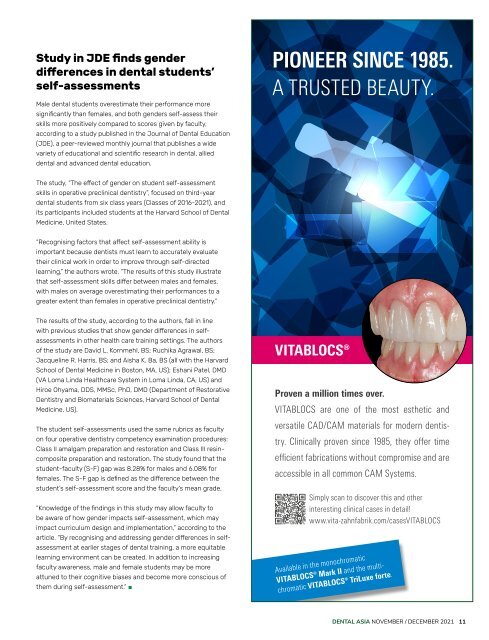Dental Asia November/December 2021
For more than two decades, Dental Asia is the premium journal in linking dental innovators and manufacturers to its rightful audience. We devote ourselves in showcasing the latest dental technology and share evidence-based clinical philosophies to serve as an educational platform to dental professionals. Our combined portfolio of print and digital media also allows us to reach a wider market and secure our position as the leading dental media in the Asia Pacific region while facilitating global interactions among our readers.
For more than two decades, Dental Asia is the premium journal in linking dental innovators
and manufacturers to its rightful audience. We devote ourselves in showcasing the latest dental technology and share evidence-based clinical philosophies to serve as an educational platform to dental professionals. Our combined portfolio of print and digital media also allows us to reach a wider market and secure our position as the leading dental media in the Asia Pacific region while facilitating global interactions among our readers.
Create successful ePaper yourself
Turn your PDF publications into a flip-book with our unique Google optimized e-Paper software.
Study in JDE finds gender<br />
differences in dental students’<br />
self-assessments<br />
Male dental students overestimate their performance more<br />
significantly than females, and both genders self-assess their<br />
skills more positively compared to scores given by faculty,<br />
according to a study published in the Journal of <strong>Dental</strong> Education<br />
(JDE), a peer-reviewed monthly journal that publishes a wide<br />
variety of educational and scientific research in dental, allied<br />
dental and advanced dental education.<br />
PIONEER SINCE 1985.<br />
A TRUSTED BEAUTY.<br />
The study, “The effect of gender on student self-assessment<br />
skills in operative preclinical dentistry”, focused on third-year<br />
dental students from six class years (Classes of 2016-<strong>2021</strong>), and<br />
its participants included students at the Harvard School of <strong>Dental</strong><br />
Medicine, United States.<br />
“Recognising factors that affect self-assessment ability is<br />
important because dentists must learn to accurately evaluate<br />
their clinical work in order to improve through self-directed<br />
learning,” the authors wrote. “The results of this study illustrate<br />
that self-assessment skills differ between males and females,<br />
with males on average overestimating their performances to a<br />
greater extent than females in operative preclinical dentistry.”<br />
The results of the study, according to the authors, fall in line<br />
with previous studies that show gender differences in selfassessments<br />
in other health care training settings. The authors<br />
of the study are David L. Kornmehl, BS; Ruchika Agrawal, BS;<br />
Jacqueline R. Harris, BS; and Aisha K. Ba, BS (all with the Harvard<br />
School of <strong>Dental</strong> Medicine in Boston, MA, US); Eshani Patel, DMD<br />
(VA Loma Linda Healthcare System in Loma Linda, CA, US) and<br />
Hiroe Ohyama, DDS, MMSc, PhD, DMD (Department of Restorative<br />
Dentistry and Biomaterials Sciences, Harvard School of <strong>Dental</strong><br />
Medicine, US).<br />
The student self-assessments used the same rubrics as faculty<br />
on four operative dentistry competency examination procedures:<br />
Class II amalgam preparation and restoration and Class III resincomposite<br />
preparation and restoration. The study found that the<br />
student-faculty (S-F) gap was 8.28% for males and 6.08% for<br />
females. The S-F gap is defined as the difference between the<br />
student’s self-assessment score and the faculty’s mean grade.<br />
“Knowledge of the findings in this study may allow faculty to<br />
be aware of how gender impacts self-assessment, which may<br />
impact curriculum design and implementation,” according to the<br />
article. “By recognising and addressing gender differences in selfassessment<br />
at earlier stages of dental training, a more equitable<br />
learning environment can be created. In addition to increasing<br />
faculty awareness, male and female students may be more<br />
attuned to their cognitive biases and become more conscious of<br />
them during self-assessment.” ■<br />
VITABLOCS®<br />
Proven a million times over.<br />
VITABLOCS are one of the most esthetic and<br />
versatile CAD/CAM materials for modern dentistry.<br />
Clinically proven since 1985, they offer time<br />
efficient fabrications without compromise and are<br />
accessible in all common CAM Systems.<br />
Simply scan to discover this and other<br />
interesting clinical cases in detail!<br />
www.vita-zahnfabrik.com/casesVITABLOCS<br />
Available in the monochromatic<br />
VITABLOCS® Mark II and the multichromatic<br />
VITABLOCS® TriLuxe forte.<br />
© Dr. Julio Gomez Paris, Santa Fe, Argentina<br />
DENTAL ASIA NOVEMBER / DECEMBER <strong>2021</strong> 11<br />
3591E_VITABLOCS_Gomez-Paris_95x250.indd 1 21.09.<strong>2021</strong> 10:58:43


















